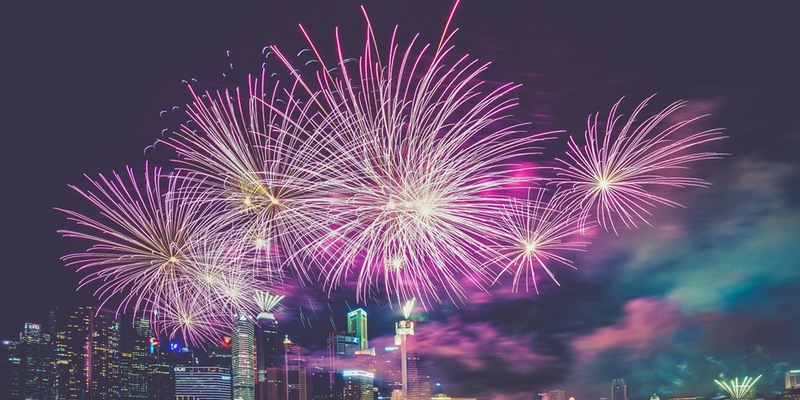New Year’s Eve Traditions around the World

Out with the old year, in with the new: New Year’s Eve is widely celebrated all over the world, with parties and social events, fireworks, dancing and festive dinners. On top of all that, every country has developed its own special traditions. Let’s have a look at how other countries celebrate the turn of the year!
Red underwear – Italy
If you’re celebrating New Year’s Eve in Italy, don’t forget to put on red underwear. Both men and women wear it as it is said to bring good luck in the coming year. Besides, red is the colour of fertility, so those hoping to conceive will also wear red. The traditional dinner consists of pig’s trotter and lentils (zampone e lenticchie) – this hearty meal is also believed to bring prosperity and good luck.
Smashing plates and jumping off chairs – Denmark
In Denmark, it’s a big New Year’s Eve tradition to smash plates on your friends’ and family’s front doors. It is considered a sign of good luck to find a heap of broken china on your doorstep on New Year’s Day. Moreover, at the stroke of midnight, Danes jump off chairs. Leaping into the New Year symbolises the overcoming of potential challenges in the year ahead.
Dinner parties – France
In France, New Year’s Eve is celebrated with a feast, le Réveillon de la Saint-Sylvestre. Special dishes include foie gras, seafood such as oysters, and champagne. From simple, intimate celebrations with friends and family to bigger parties or fancy balls, there’s something for every taste. On New Year’s Day, kisses, good wishes and New Year’s resolutions are exchanged.
Suitcase walk – Latin America
For many Latinos from Chile, Colombia and Ecuador to Mexico it is customary to take an empty suitcase for a walk on New Year’s Day (or even at the stroke of midnight). This is to ensure that the coming year is filled with travel and adventure.
First-footing – United Kingdom
In the UK, Bonfire Night/Guy Fawkes Day (November 5) is the more prominent date for fireworks, but of course there are many public firework displays around the UK on New Year’s Eve (Scotland: Hogmanay) as well. According to tradition, on the stroke of midnight, the front and back doors are opened at the same time. This is supposed to let the old year out the back door, so the new year can enter through the front door.
The practice of first-footing is very widespread: It involves being the first person to cross a friend’s or neighbour’s threshold, bringing symbolic gifts such as coal, bread and salt. These are intended to bring different kinds of luck for the new year, especially if it is coming from a stranger. Singing Auld Lang Syne, the Scottish song by Robert Burns, at the conclusion of New Year parties and gatherings is also customary.
Lucky grapes – Spain
In Spain, it’s a New Year’s Eve tradition to eat grapes at midnight – 12 in total, one for each stroke of midnight. In Madrid, it occurs in conjunction with the clock tower at the Puerta del Sol. Eating 12 grapes in 12 seconds – no easy feat, by the way – will supposedly bring you good luck for the coming year, which is why they are called “las doce uvas de la suerte“ (the 12 lucky grapes).
Dressing in white – Brazil
The New Year (Ano Novo) marks the beginning of the summer holidays in Brazil, which last until Carnival. Traditionally, Brazilians have a copious meal with family or friends, drink champagne, watch the fireworks and eat grapes, rice or lentils, which are said to bring good luck. It is customary to dress in white, also including all the people who celebrate at the beach. The colour white is a sign of peace and prosperity. Other customs involve jumping over seven waves, while making a wish for every wave and, in Rio de Janeiro, throwing white flowers and other offerings into the sea for the sea goddess Iemanjá, in the hope that she will grant the wishes.
Dinner for One – Germany
In Germany, the new year is greeted with copious fireworks and sparklers, as it is the only time of year when fireworks are sold to people. At parties with friends or family Germans toast the New Year with a glass of Sekt (German sparkling wine). Watching the English comedy sketch Dinner for One (about an upper class lady’s 90th birthday) is a typical tradition for many Germans, as is telling fortunes by the shapes made by molten lead that is dropped into cold water (Bleigießen). Watch it below!
108 rings – Japan
At midnight on New Year’s Eve, Japanese Buddhist temples ring their bells a total of 108 times to symbolise the 108 human sins in Buddhist belief. Ringing the bells 108 times will rid believers of their evil passions and purify them for the coming year.
Apple oracle – Czech Republic
It is a Czech custom around New Year’s Eve to look to your future with the help of an apple. It is cut in half and the shape of the core determines the person’s fate. If it’s a cross, mischief is coming, but a star means you can expect happiness. Lentils are a popular midnight snack on this night, as they are symbolic of financial success.
